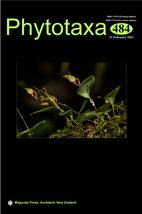Abstract
Maximum Likelihood (ML) and Bayesian analyses (BI) applied for 3-plastid loci (cpDNA trnL(UAA) intron, trnL–trnF IGS, and rpl32–trnL(UAG) IGS regions) / 55 tips of Atraphaxis revealed a subclade of two endemics from Transbaikalia (Dahuria) which are often mistaken for A. pungens and A. frutescens but phylogenetically distant from both. Atraphaxis selengensis is a species new to science which inhabits dune sands along the Selenga and Chikoy rivers and has specific morphology of perianth, fruits, ochreas, leaf blades, and pollen. Atraphaxis davurica inhabits stony mountain steppe in Buryatia and Chita region and differs from A. pungens and A. frutescens by longer ochreas, fruits, styles and stigmas extended to ends. Two varieties recognized by Ledebour in plants from Russian Transbaikalia have no clear morphological and molecular distinctions, but the plants from Khentei-Chikoy Highlands subtly differ in leaf ratio (length/width), bark colour, and a single-nucleotide substitution in trnL–F region. These plants are described as A. davurica var. chikoensis var. nov. Morphological descriptions of A. selengensis and A. davurica are supplied with LM and SEM images and a distributional map. Atraphaxis frutescens and A. pungens are absent from Russian Transbaikalia but distributed in Altai, Tuva, Khakassia, Mongolia and China.

